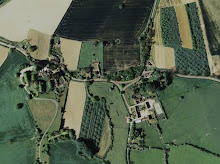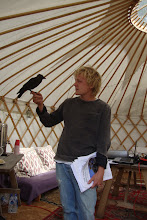

This is Tanya carefully lifting the lid on the hive in the 1920s orchard. That beautiful construction is wild bee comb and represents the natural form of a bee comb, the home of the colony. It is so pale because it has been made recently - over time apparently it will become browner with the build up of propolis. Unfortunately, comb like this is more tricky to manage than comb built on the removable frames you can see to the front of the hive. Ideally we would have filled the hive with these frames before they managed to build this natural comb and thus forced them to build on the frames. Still, what a wonder to behold!

Most commercial beekeepers would break up the natural comb into flat sections and attach it using string or elastic bands to the frames, thus allowing the colony to be managed much more easily. Since I don't have to be as efficient we decided on a compromise where we left the bulk of the natural comb but filled the rest of the hive with frames for them to move onto as the colony grows.

Here I am using the smoker to move the bees around and try and prevent any from being squashed. Smoke irritates them and they shy away from it. Amazingly, the bees didn't seem to get too bothered with our meddling and they didn't try and sting us. Phew!

We took a small piece of comb out to have a taste. The cells on one side are filled with nectar and the darker cells contain pollen which you can also eat. The bees have not yet started converting the nectar into honey. They do this by adding an enzyme and reducing the water content. This allows them to store energy supplies since honey will not ferment (it is in fact the only type of food that never goes off in pure form!). When the colony gets bigger I can add another story to the hive and sustainably harvest some honey periodically. We ate it with the first strawberries of the year. Very decadent!



Great post. Did you see Stephen Hayes video of slightly less docile bees in his orchard: http://www.youtube.com/watch?v=jHTS0A2J6U4
ReplyDeleteExcellent news - we all need bees!
ReplyDelete